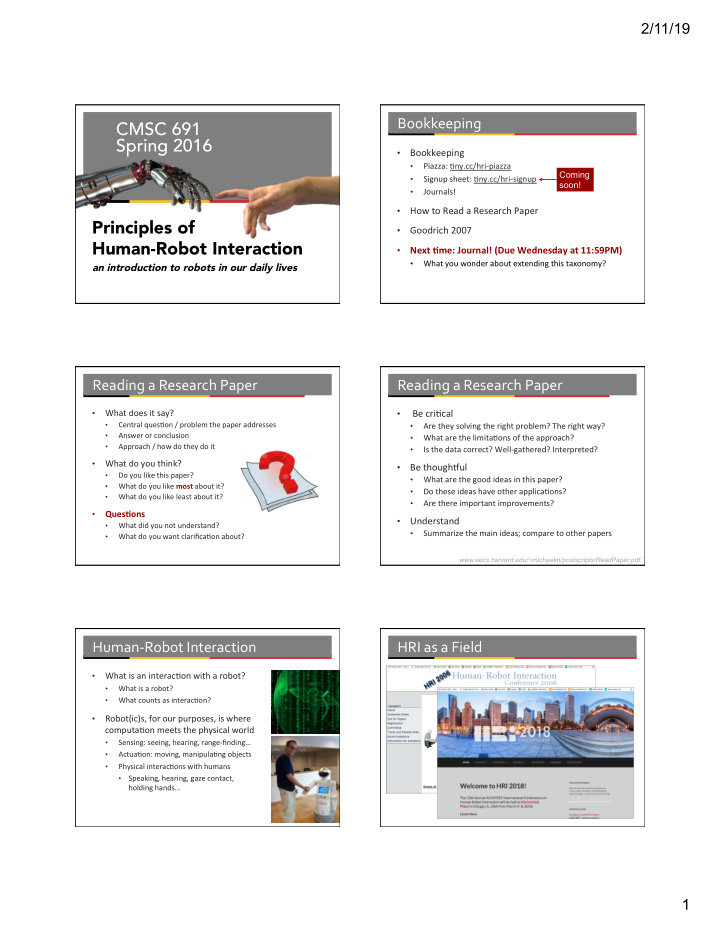



2/11/19 Bookkeeping CMSC 691 Spring 2016 Bookkeeping • Piazza: .ny.cc/hri-piazza • Coming Signup sheet: .ny.cc/hri-signup • soon! Journals! • How to Read a Research Paper • Principles of Goodrich 2007 • Human-Robot Interaction Next &me: Journal! (Due Wednesday at 11:59PM) • What you wonder about extending this taxonomy? • an introduction to robots in our daily lives Dr. Cynthia Matuszek Reading a Research Paper Reading a Research Paper What does it say? Be cri.cal • • Central ques.on / problem the paper addresses • Are they solving the right problem? The right way? • Answer or conclusion • What are the limita.ons of the approach? • Approach / how do they do it • Is the data correct? Well-gathered? Interpreted? • What do you think? • Be thoughSul • Do you like this paper? • What are the good ideas in this paper? • What do you like most about it? • Do these ideas have other applica.ons? • What do you like least about it? • Are there important improvements? • Ques&ons • Understand • What did you not understand? • Summarize the main ideas; compare to other papers • What do you want clarifica.on about? • www.eecs.harvard.edu/~michaelm/postscripts/ReadPaper.pdf Human-Robot Interaction HRI as a Field What is an interac.on with a robot? • What is a robot? • What counts as interac.on? • Robot(ic)s, for our purposes, is where • computa.on meets the physical world Sensing: seeing, hearing, range-finding… • Actua.on: moving, manipula.ng objects • Physical interac.ons with humans • • Speaking, hearing, gaze contact, holding hands... 1
2/11/19 Design Axes to Consider Competitions and Areas Driving • Autonomy (or “neglect tolerance”) • Sometimes Can it func.on by itself? Search & Rescue • we don’t care! • Useful near-term • Informa.on Exchange • Do we need to know what Hors d’oeuvres, anyone? • it does, and vice versa? Who knows what, when? • Crowd naviga.on, direct social interac.on • Assis.ve Robo.cs Team Structure • • Harder than Social, physical, and cogni.ve support • Humans, robots, so^ware agents… autonomy • Vulnerable popula.ons • Adapta.on and Learning Space and Extreme Condi.on Robo.cs • • When shouldn’t a robot learn? Extreme opera.ng condi.ons • “Shape of the Task” • • Par.al, delayed, or no communica.on Robocup Search and Rescue Search and Rescue fewkahbc • Space Robots Assistive Robotics Mars InSight, NASA www.youtube.com/watch?v=Zd9WhJPa2Ok Valkyrie, NASA Curiosity, NASA Dextre, Canadian HAL exoskeleton: construc.on, disaster response www.enablemart.com/obi-feeding-device 2
2/11/19 Assistive Robotics Assistive Wheelchairs Cyberdyne rehab exoskeleton www.youtube.com/watch?v=t2SHKyq5yCU- Chiba group Assistive Robotics Assistive Robotics RIBA-II Transfer Robot Casper Cognitive/Social Assistant Assistive Robotics Social Robotics Intelligent System Corporation PARO social robot Leonardo, Personal Robot Group, MIT 3
2/11/19 Types of Interaction Types of Interaction Autonomy Interaction Non-interac.ve work Engineering: • • Directness S.ll doing tasks for humans Building, maintaining, (re)programming Low • • Low Teleopera.ng Teleopera.ng • • Supervising Supervising • • • Correct errors, give low-level instruc.ons • Correct errors, give low-level instruc.ons There are a number of formal Providing goals Providing goals • • autonomy scales! From “Pick up the block” to “Cook dinner” From “Pick up the block” to “Cook dinner” • • Non-supervisory interac.ons Non-supervisory interac.ons • • With people With people • • In environments (e.g., cleaning) In environments (e.g., cleaning) • • High High System Design Autonomy How autonomous should (this) robot(s) be? How autonomous should this robot(s) be? • • For what kind of interac.on? • What kind of group is the robot in? • What is the target problem(s)? • Other robots? Humans? • Are their human collaborators? • How is it structured? Who’s in charge? • Par.al; full; social; correctable; hap.c; feedback; … • Informa.on management • What kind of autonomy? • Who knows what? Is it transferred? • Goal-based • In practice, these are incredibly How adap.ve or predefined is the task? • Behavior-based high-level simpli6ications of all of • arti6icial intelligence – but useful! What is the task or task domain? Probabilis.c • • Information Exchange Information Exchange (II) Who knows what? Who needs to know what? • The medium • When informa.on transferred: • Many human- Seeing • When exactly? robot • Hearing • From whom to whom? interactions • Touch • How slow? How costly? • can also be human- How informa.on is transferred: • human, robot- • Using what media? robot, or a “Put the pot here In what format? (Scripted, one-way, free?) and hand me the • more complex sugar, please” mix. This is Do you need a cogni.ve model • OKAY why I often of the agents? say agent . 4
2/11/19 Group Makeup Adaptation What can be learned? Humans and robots • • Progressively Task domain; task ac.ons • more! • 1-1, many-many, 1-many, many-1, 1-0, 0-many, … • Changes over .me Related to autonomy, task • Communica.on style and kind • Who has authority? Who has responsibility? • Authority and communica.on flow • When does the human not have pure authority? • What can change? • Timing? Task-based? • The task? The authority? Agent capabili.es? • Over what span of .me? What is op.mal? • • In response to what informa.on? • What agent(s) should do the learning? • Autonomy Authority Practical Discussion Search & Rescue • • Autonomy Assis.ve Robo.cs • Transfer • • Group Structure Social • Wheelchair • • Informa.on exchange Space/Extreme • • Adapta.on and Learning Condi.ons Surgical • Hors d’oeuvres, anyone? • 5
Recommend
More recommend